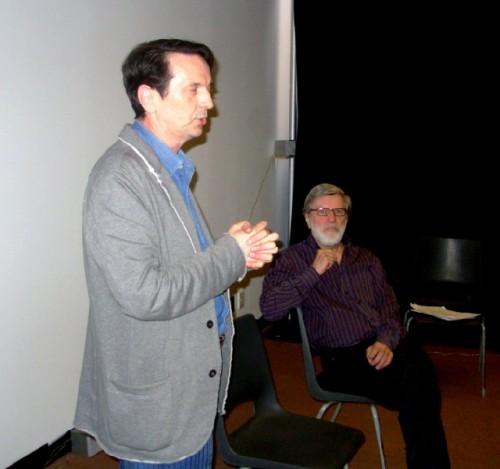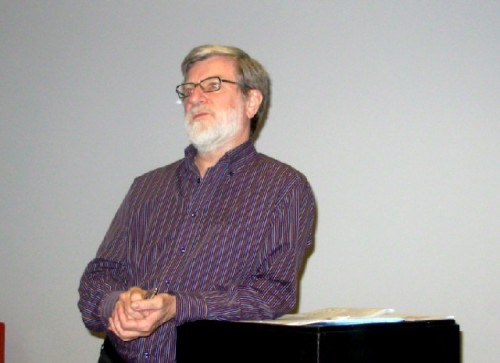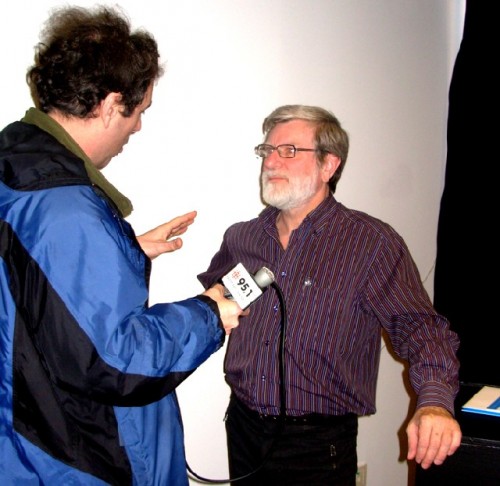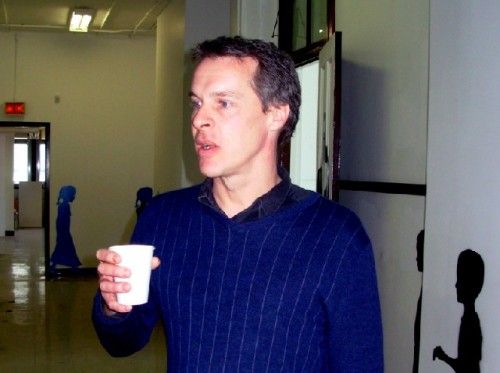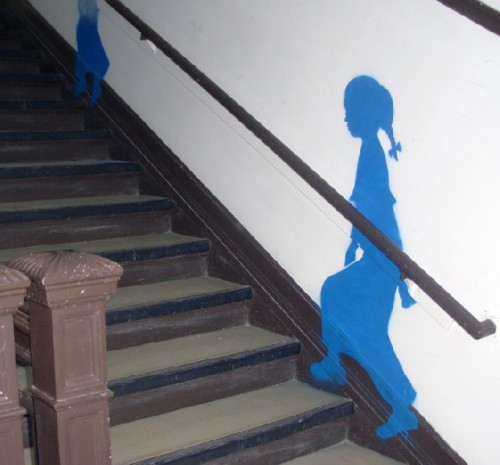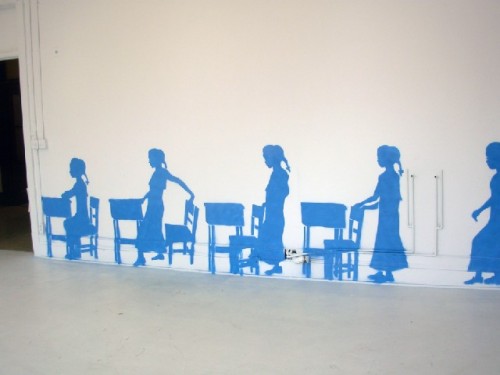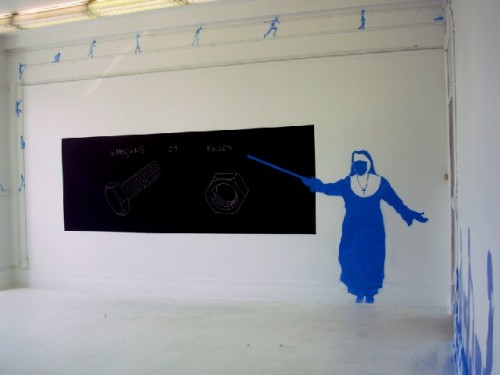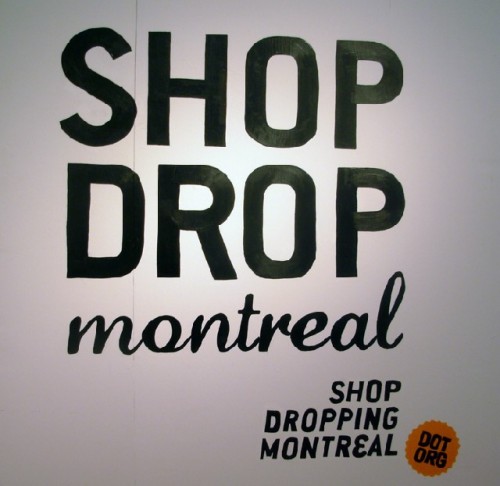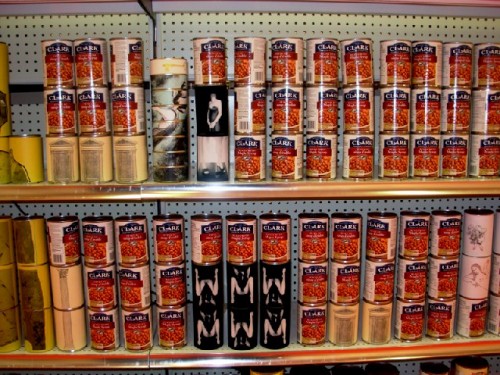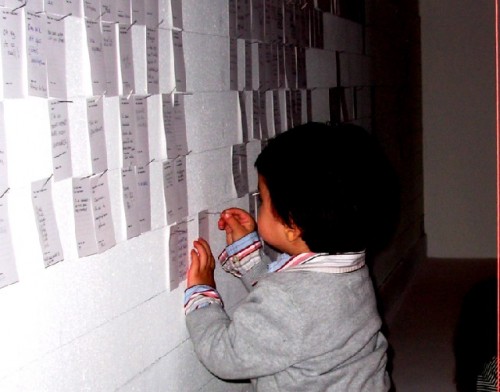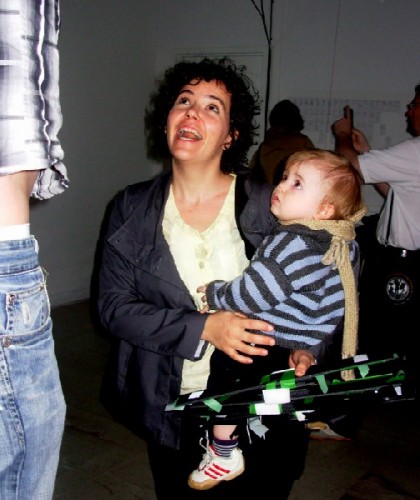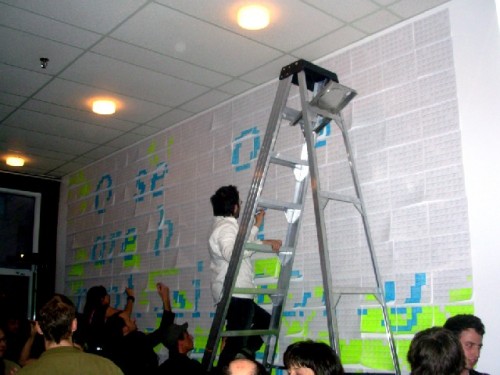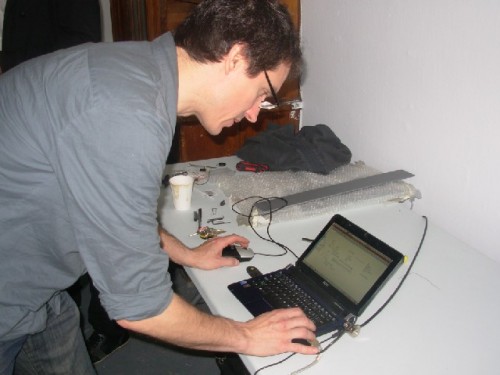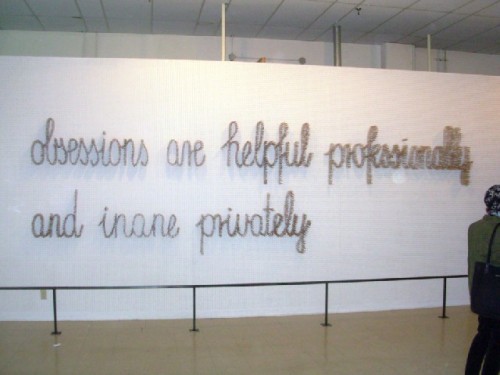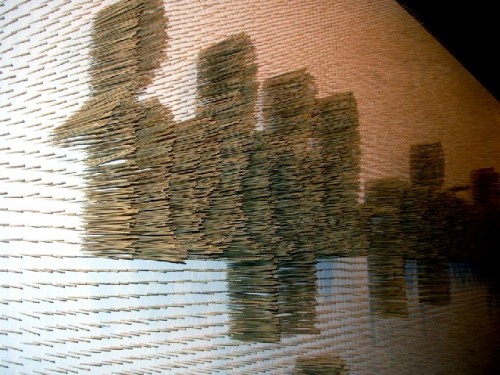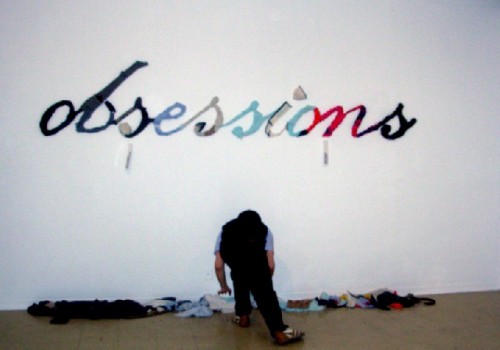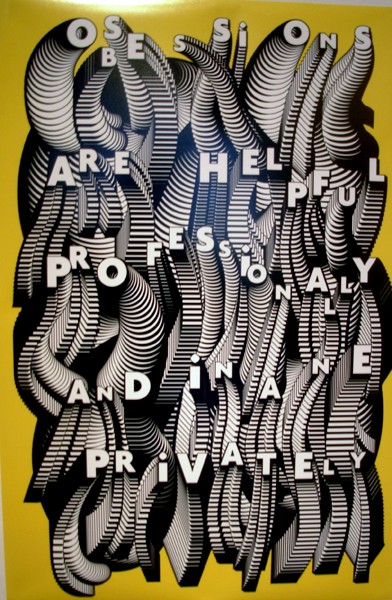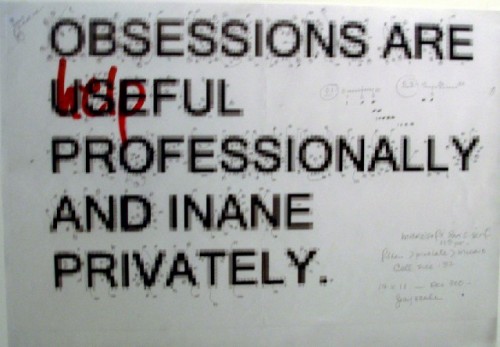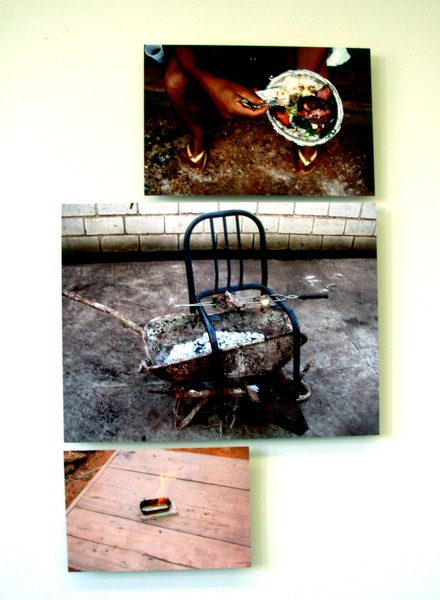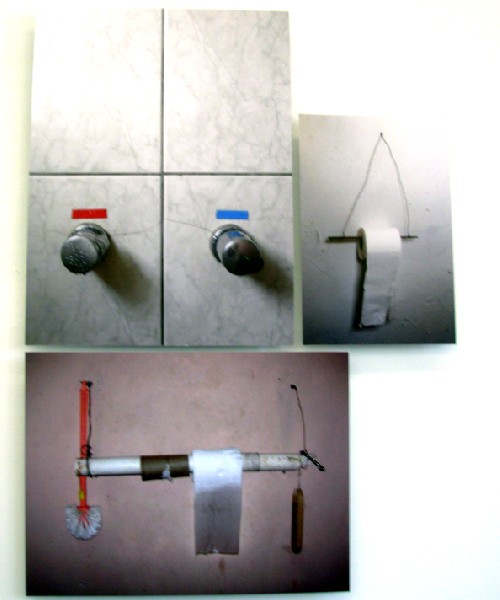Biennale de Montreal 2009
Exploring the Theme of Open Culture
By: Charles Giuliano - May 05, 2009
The implosion of the global economy has taken the inflated art world down with it. During the seemingly endless expansion before the crash there was a complex network of international art fairs, clusters of gallery districts as virtual city states- Chelsea as a kind of art Vatican within Manhattan- with some 300 biennials and counting. Issues of Art Forum were so bloated with ads and slim on editorial content that they seemed more like fashion magazines than a matrix for critical discourse.
Currency in the art world was measured by frequent flyer miles. The top tier of artists, critics, collectors and curators were in a perpetual state of jet lag. In such a swirl of activity there was little prospect of absorbing and digesting the glut of information. There were field reports as sound bites and gossip regarding which booth sold out during the opening night benefit of this or that art fair. Or the installation that begged for a flight to some remote location and its biennale.
The art in this over commercialized process was the chum or bait cast on the waters to attract the schools of fish which in turn draw in the sharks and major predators. In Vegas such individuals are known as the whales. They are the ones comped with suites in the best hotels, wined and dined, as long as they leave their cash at the tables. In this cultural paradigm art is about spectacle and a form of entertainment. For a time it appeared that everyone was a winner. There was a herd mentality as a core of collectors competed for the same goods creating competition and jacking up prices.
Those hip or fast enough to spot emerging talent saw modest initial investments run up faster than speculation in real estate or the stock market. Collectors often functioned as wolves in sheep's clothing as works were sold to create assets for reinvestment. Back in the 1960s it was scandalous when Robert and Ethel Scull sold off the works of their Pop art friends. Similarly, Charles Saatchi has, from time to time, dumped works to buy new ones. These mega collectors were able to greatly influence and manipulate the worth of artists.
Then the music stopped. There were not enough chairs. Sales slowed down during Spring/ Summer of 2008 and fell off the cliff with the collapse of the stock market in October/ November. After a peak of 14,000s the DOW plunged to a bottom of 6500 and has now "recovered" to the plus side of 8000. Having lost their shirts few of the mega collectors continue to view art as a sure bet and safe investment. This is reflected in the auction houses and secondary markets where only blue chips are likely to sell or meet lowered reserves.
At least for now, or until a recovery that nobody feels confident to predict, the old ways of the art world are gone. Rather than lament, however, there are new possibilities for creativity, invention, risk taking and entrepreneurship. In all aspects of market enterprises we see industries in the process of invention and reconstruction. If the Big Three automobile companies, for example, are to survive they must reduce redundant brands and models while focusing on making products that consumers are actually looking for. As newspapers down size or fold they give way to blogs and electronic communication..
There will be an art world and market but not one nurtured by business as usual. More likely the change, progress and energy will come from the ground up. Particularly, from the generation of artists now emerging from schools. If the infrastructure of galleries and art fairs is reduced or dismantled emerging artists will find other ways to create and promote their work. There is likely to be less incentive to make consumer products.
The art that is bubbling up is the result of a different urgency. It is driven by new developments in communication and technology. The work will come from a youth based subculture. Those rooted in the old art world just won't get it. The gap will grow ever wider between information and communication, open sourced and appropriation based mandates vs. the ponderous, product based studio/ gallery traditions. The new work is less about selling than sharing issues and ideas. It is not so much about ego and the star system. There will be fewer big payoffs for the insider traders. The pace makers are more likely to be geeks than slicksters with MBA's, or graduates of arts administration, and critical studies programs.
Of course there will be art stars and individuals who will prosper. They just won't show at Gagosian Gallery or the American Pavilion of the Venice Biennale. There won't be feature articles on the work in Art in America, Art Forum, or the Village Voice. But there will be a lot of chatter on blogs, Twitter, Face Book and emerging art and social networks. One already sees that paradigm shift.
As a witness to and participant in the spectacle of the demise and fall of the art world, as well as, its inevitable reinvention it is intriguing to look for new vectors of progress and discourse. Two years ago we staggered through the Venice Biennial and were up to speed with the critical flogging of its chief curator, Robert Storr. Given the opportunity, he showed his friends in Venice with predictable and enervating results. He snarled back at his detractors in exchanges of letters in Art Forum. But the discourse seemed so Ancien Regime circa 1788. It was the last gasp of the Royalists even though Storr protested with outraged bathos that he had in fact reinvented the most prestigious, superannuated and outmoded of the biennales. There was nothing he could do about those national pavilions which have long ago ceased to be relevant.
We are about to experience a new Venice Biennale. There is always hope and possibility for change. But, perhaps like the Big Three automakers in Detroit, Venice is just too big, ponderous, and set in its ways to respond to the new global mandates. Don't expect to see the future at Venice.
For glimpses of the new paradigms it is better to seek out the network of fringe biennials and smaller, more focused art fairs. It was for this purpose that we attended with great interest the Biennale de Montreal 2009. Not that it provided answers, or even lived up to expectations, but one could sense the seismic tremors of the tectonic shifts of the art world.
Not to say that I understand or can explain what we experienced in Montreal last week for the opening of the Biennale which continues for just one month ending on May 31. Its very successful education program, because of intense demand by school groups, will be extended by an additional week.
This, the 6th Biennale de Montreal is by far its most challenging and risk taking. Many factors, primarily funding, encouraged such an avant-garde approach. There are no international art stars and the focus is primarily on experimental aspects of Canadian fine art, design, music, video and cinema. This is an important signifier as more and more of the global biennials, particularly the smaller ones, concentrate on artists of the host nations and regions. One noted this recently, for example, in reports on the Havana Biennale. Although there was a presence of New York dealers like Jack Shainman who has concentrated on Third World artists.
As always, Claude Gosselin, the Directeur general and artistique of Centre international d'art contemporain de Montreal (CIAC), which produces the Biennale, struggled with the issues of budget and real estate.CIAC also publishes a bilingual Electronic Magazine As a "fringe" Biennale each CIAC project represents a mandate for reinvention. In this case, for example, Ecole Bourget, 1230 rue de la Montagne, the primary site for the Biennale is a kind of found object adapted to the needs for exhibitions. The former class rooms, with very little alteration, function as a series of galleries. The number of participating artists and projects were limited to the available spaces. There was also consideration of what work and projects would best adapt to the architecture with a minimum of alteration.This is quite different from the enormous budgets enjoyed by curators of Venice, Sao Paulo, or Documenta.
Having attended the opening of the Biennale de Montreal we are prepared to offer only limited observations. In order to properly "review" the project would entail more than just a few days. As indicated in a prior article, with the full schedule of events, there is a dense agenda with many simultaneous daily activities including satellite venues, lectures, and colloquia. One of the mandates of the project is to provide a matrix for research and development as artists and programmers interact with the public in person and on line. There is an enormous range of activity beyond a large exhibition.
Of course, this is hardly unique to Montreal. Most biennials entail complex programming. The 2002 Documenta 11 of Okwui Enwezor, for example, entailed several "platforms" in diverse locations before the opening of the exhibitions in Kassel, Germany. The research findings of those platforms, including a complex dialogue regarding "Creolite," were published in the dense text of an addendum to the primary catalogue. Documenta 10 of Catherine David entailed 100 days of lectures and seminars conducted in the Documenta Halle with furniture designed by the Austrian artist Franz West.
Because a typical biennale/ biennial lasts for one to three months, with a lot of programming, it is possible at best to cover only a sliver of the overall activity. It was calculated that it would have taken at least 200 hours just to see all the video art presented in Documenta 11. When we attended we spent two days looking at the exhibitions and a third day devoted just to video. Ultimately we viewed and reported on just a fraction of that daunting experience.
Rather than a "review" of the current Montreal Biennale what is really called for is a case study. Perhaps it should be assigned to MBA students at the Harvard Business School. One would want access to all of the financial reports and minutes of meetings with curators, government officials, foundations and funding sources. Just how does one make such a project? What are the mandates and considerations? How do the finances influence aesthetic decisions? Does the Biennale encourage travel and tourism to Montreal? Is there a way of measuring the impact on the economy of Montreal? In what way is the Biennale a part of the marketing strategy for seasonal tourism? In what manner may the Biennale be compared to Montreal's Jazz, Film and Just for Laughs festivals?
The actual work on view in the Biennale is the tip of the iceberg and not necessarily the most compelling or interesting aspect of a project. In what way is this Biennale unique or different from others? There are curators who run around the circuit viewing each other's projects. This has resulted in the phenomenon of what is called "Festival Art" ambitious expensive installations that are featured over and over. If you see enough biennials there is a sameness. They tend to feature the usual suspects.
Until, of course, the recent meltdown which has leveled the playing field. With the art dealers suffering staggering losses of sales there is a reluctance to pick up the tab for transporting and installing work on the biennial circuit. For the honor of representing one's nation in a pavilion in Venice, for example, it was expected that an artist's dealer pay for the costs of an installation. In the old paradigm this added to the prestige of the artist and the dealer would earn back expenses through the increased net worth of the works displayed.
So we arrived in Montreal with a complex agenda and expectations. It started in Boston when we engaged in dialogue with Gosselin during the conference International Opportunities for Artists. We had experienced several of his past projects including Les Cents jours which was the format predating the first Biennale 12 years ago. I had always been fascinated by the entrepreneurial spirit and inventiveness of his projects. He spoke about the current project during what could have been an insightful panel. The curator, Uta Meta Bower, attempted to provide an overview of the current state of biennials, but was disrupted by the self absorbed David Medalla. It is an important dialogue that deserves to be heard.
Of course heightened expectation sets up inevitable disappointment. While ambitious and provocative the current Biennale seemed limited in resources and not entirely evolved. It feels transitional. There is the sense that out of the seeds of this project will emerge the template for another.
Dealing with the current Biennale de Montreal we came to grips with what is and isn't. In conversation with one of the participating artists, Daniel Jolliffe, for example, he was enthusiastic in pointing out that there was very little of the usual art as commodity; not much in the way of "collectable" paintings and objects. Ironically, his own work, a bicycle which he pedals about the city with a loud speaker system, may be viewed as a form of sculpture. We are invited to send him one minute messages which become a part off the agit-prop street blasts.
A couple of days later, having viewed and engaged with a lot of the projects, I resumed a conversation. If there is no presence of art stars, and commodity art, with so much emphasis on process, interaction, programming and the internet, why then the need for real estate? Why not have an "on line biennale?" One might log onto a site as matrix, link and network from there. The Montreal Biennale would be the epicenter, source and station for a global project. It would certainly be cost effective and provocative with the prospect of millions of visits and hits. "Yes," Jolliffe responded, "But you wouldn't have this, the person to person human factor." The unique dialogue that exists between the artist/ presenters and their audience of visitors. That is a point of enormous value. Which was abundantly evident during the well attended vernissage. There was overwhelming evidence of individuals interacting with the work. It was a very young and engaged audience entirely in sync with the agenda of the Biennale.
During the press conference we spoke with Lynn Hughes a coordinator of Lab Poreux/ Porous Lab. She is a dean at Concordia University involved with the study and development of games. It seems that Montreal and Vancouver are renowned as centers for alternative game development. This is precisely the kind of grass roots, youth mandated art and culture which is little understood and studied by the mainstream. During the opening the room was packed with individuals playing with a variety of games. It was a culture of which I have little or no direct knowledge. So I am very grateful to this exposure through Hughes and the Biennale.
The handout that Hughes gave me states that "We are the Technoculture, Art and Games/ Jeux research group. TAG brings together academics (and students) from a wide range of disciplines with artists, designers, programmers, and other individuals interested in the criticism, conception, design and dissemination of new and interesting game forms. TAG is based at Concordia but includes people from other universities as well as from outside the universityÂ…"
The project of Peter Gibson, or Roadsworth, was simple, clever and successful. The artist is known for stencils on sidewalks and aspects of public art, which is to say, not in galleries. He took the notion of the Biennale as located in an abandoned school and brought back the students. They are stenciled on sidewalks on their way to school, on the walls of the stairwells, along the corridors, and finally, in the classroom. Next to the blackboard is a stencil of the nun/ teacher with her pointer. On the blackboard is a parody of sex education as the nun appears to be lecturing on the function of a nut and its bolt or male/ female connections.
A classroom/ gallery presented the project of Shopdropping. This is the opposite of Shop Lifting where one steals from a store. In this case, as a guerrilla activity, artists change labels on canned goods. Imagine visiting a supermarket and finding provocative labels and configurations instead of beans. There were maps on the walls illustrating locations of global activity. We discussed this with the artist Vandra Daftari who was arranging the goods on ersatz shelves. During the Biennale this activity is going on at locations all over the city. One wonders about the legal implications for artists apprehended in the midst of this subversive activity. It would not be surprising to have some store owners and consumers freaked out by the notion of someone playing with the food.
For the Biennale the renowned Austrian designer, Stefan Sagmeister, contributed the phrase "Obsessions are helpful professionally and inane privately." It was taken from a diary that includes some 20 maxims "Things I have learned in my life so far." Artists were invited to submit design proposals and a jury selected the room filled with responses to the phrase. Of these the most engaging was a wall with the phrase spelled out by projecting bamboo sticks. More variations will occur during the run of the Biennale.
The central theme of this Biennale, Libre/ Open, is the idea among youth today that everything is open source. There is a resistance to copyright, exclusivity, and ownership. In the counterculture we tag or spray over each others ideas and designs like walls of graffiti. The palimpsest is a fundamental notion. If you log onto Facebook and Twitter, for example, ideas last for just a few minutes. The message you post is just lost downstream in a river or may evoke a "thread" of commentary. But it all happens so fast that many participants send out batches of postings with hourly updates. Much of this communication is numbingly banal but has stood on its head notions of ownership and originality. Montreal's Biennale offers glimpses of how the Twitter/ Facebook culture is eating its way into the art world mainstream. One might also argue that it does not go far enough. The entropy of Libre/ Open is to abandon property, burn down the house, and camp in the woods.
But isn't that what Joseph Beuys was getting at with his Free University and actions? There is freshness as well as recycling of ideas when engaging youth culture. There is the excitement of the here and now but very little knowledge or interest in the past. So artists reinvent the wheel with reckless abandon and enthusiasm wallowing in an ersatz conceit of originality. While it is evocative to engage with young artists, new ideas, and emerging technologies the discourse is not always articulate. Communication skills take time to develop beyond the bursts of Twitter and postings on Facebook. Have a nice day.
For me, the greatest pleasures of contemporary art are surprise and invention. Most treasured is an economy of means. The readymades of Marcel Duchamp were so direct and iconic. They were brilliant and understated compared to the sweat and testosterone of a labor intensive cubist painting. It often seemed that Duchamp was light, clever, and playful while Picasso tried too hard. Duchamp was the greater master and the more enduring influence.
A case in point was the wonderful Montreal project of the Brazilian artist Cao Guimares. The room with groupings of photographs only made sense after viewing an accompanying video on the subject of Gambiarras. This is a Third World phenomenon of creating functional objects from found and recycled materials. The video demonstrates with side splitting humor how to replicate an expensive object or solve a practical problem. Absurdly, we view a man trying several techniques to dry a pair of sneakers. One approach is to whirl them around in the air until exhausted by the effort, to spin them in a rigged up machine, or blot them with paper. None of these schemes prove to be very effective but the video and installation of photographs represent a hilarious metaphor for the Third World Economy in which nothing is wasted and everything is recycled. This work was just brilliant.
So yes, we learned a lot in the Biennale de Montreal. Most importantly it offered priceless clues for the future. Yes, there is hope. Not just the Shepherd Fairey inspired Obama poster. When push comes to shove, and all else fails, at least I have come away with some good ideas on how to dry my sneakers.


